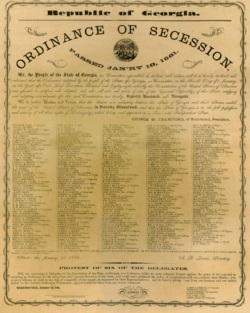Ordinance of Secession facts for kids
Quick facts for kids Ordinance of Secession |
|
 Facsimile of the 1861 Ordinance of Secession signed by 293 delegates to the Georgia Secession Convention at the statehouse in Milledgeville, Georgia January 21, 1861
|
|
| Created | c. January 20, 1861 |
| Ratified | Ratified January 19, 1861 vote was 208 yeas 89 nays Signed January 21, 1861 by 293 delegates Enacted January 22, 1861 |
| Location | Engrossed copy: University of Georgia Libraries, Hargrett Library |
| Authors | George W. Crawford et al. Engrosser: H. J. G. Williams |
| Signers | 293 delegates to The Georgia Secession Convention of 1861 |
| Purpose | To announce Georgia's formal intent to secede from the Union. |
An Ordinance of Secession was the name given to multiple resolutions drafted and ratified in 1860 and 1861, at the beginning of the Civil War, by which each seceding Southern state or territory formally declared secession from the United States of America. South Carolina, Mississippi, Georgia, and Texas also issued separate documents explaining their reasons for secession.
Thirteen states and one territory ratified an ordinance of secession, typically by means of a special convention or by referendum. Of these, only 11 states and one territory authoritatively made secession effective by a regular means, ultimately driven by state government reliably backed by public opinion and military force. The other two states seceded ineffectively or only by an irregular means, and hence remained within the Union.
The first seven seceding states, all of the Deep South, were motivated mainly by two factors: the election in November 1860 of Abraham Lincoln, who had no support among Southern voters, and the perceived direct threat to slavery his election posed. The next four states to secede also were motivated by the same two factors, but a third and decisive factor was the Federal policy of coercion, or using military force to preserve the Union by compelling the earlier seceding states to submit.
In the remaining two states, attempted secession was belated and severely disrupted.
Though generally accepted only to have comprised 11 seceding states, these 13 states and one territory formed, by its own contemporary definition as shown by 13 stars in its official and battle flags, the Confederate States of America.
Elsewhere, overwhelming Union military intervention and mass arrests of elected lawmakers blocked the secessionist Maryland legislature even from considering the question. The Delaware legislature did, quickly and overwhelmingly rejecting secession. The unorganized Indian Territory did not document secession and was not unanimous in its orientation, but generally supported the Confederacy.
In several states, effective secession in most of the state critically destabilized or virtually eliminated state government control over a region where people widely rejected secession, favoring the Union over their state. This was particularly true of Virginia, leading to the creation of West Virginia. The same effect occurred in part of Tennessee and in other areas, but did not result in any split of other states.
| State | Rejected | Approved | Referendum | Vote | ||||||
|---|---|---|---|---|---|---|---|---|---|---|
| South Carolina | December 20, 1860 | |||||||||
| Delaware | January 3, 1861 | |||||||||
| Mississippi | January 9, 1861 | |||||||||
| Florida | January 10, 1861 | |||||||||
| Alabama | January 11, 1861 | |||||||||
| Georgia | January 19, 1861 | |||||||||
| Louisiana | January 26, 1861 | |||||||||
| Texas | February 1, 1861 | February 23 | 46,153–14,747 | |||||||
| Confederate States of America provisionally constituted February 8, 1861 | ||||||||||
| Tennessee | February 9, 1861 | February 9 | 59,499–68,262 | |||||||
| Arizona Territory | March 16, 1861 | |||||||||
| Virginia | April 17, 1861 | May 23 | 132,201–37,451 | |||||||
| Arkansas | May 6, 1861 | |||||||||
| Tennessee | May 6, 1861 | June 8 | 104,471–47,183 | |||||||
| North Carolina | May 20, 1861 | |||||||||
| Missouri | October 31, 1861 | |||||||||
| Kentucky | November 20, 1861 | |||||||||

